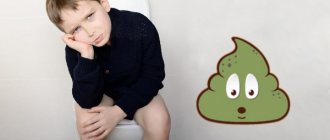Home › Child under one year old › Diseases
Author of the article
Ekaterina Rakitina Doctor Dietrich Bonhoeffer Klinikum, Germany
Reading time: 4 minutes
AA
Article last updated: 02/13/2019
If you are reading this article, it means that your one-year-old has become less likely to poop (or has not gone for a long time). This does not mean that your baby is constipated. In this regard, let's understand whether the child has problems with bowel movements or whether you are simply too suspicious a mother.
Causes and frequency of constipation in a child aged 1 year
In most cases, the causes of constipation are very different, but they are usually divided into two groups: internal and functional.
Internal causes are pathologies in the intestines that arose during intrauterine development or during the life of the baby, for example:
- Hirschsprung's disease;
- severe enlargement and distension of the intestine;
- polyps;
- adhesions and tumors.
Functional constipation occurs due to factors better known to us:
- improper feeding;
- excess fiber;
- neurogenic cause;
- dysbacteriosis;
- intoxication with various substances;
- changing your usual diet;
- allergy.
Another very important reason is improper drinking regimen. We must take into account that throughout the day the child should drink not only juices and compotes , but also plain clean water. As for the frequency of constipation, we can say: if the child is completely healthy, eats normally and drinks water, then this phenomenon will rarely occur. The more the above reasons are present in your baby’s life, the greater the likelihood of frequent occurrence of constipation.
Causes of bad stool in children
Common causes of constipation in children 3 years old
- dietary errors and lack of fluid in the diet. Usually, feeding a child monotonous foods that have a small amount of fiber leads to the development of problems with bowel movements. Also, stagnation in the intestines is affected by disruption of food intake and portion sizes.
A sedentary lifestyle often leads to the absence of bowel movements. Therefore, it is important to walk with children outside every day and teach them to exercise in the morning from an early age.
Also, constipation in children occurs when:
- congenital and acquired intestinal pathologies;
- weakening of peristalsis;
- allergic reaction to products;
- disorders of the thyroid gland;
- due to stress;
- long-term use of antibiotics and antihistamines.
In addition, constipation in children often occurs due to the presence of worms. Waste products of vital activity of which provoke the process of intoxication, which is the cause of poor intestinal function.
Symptoms
To determine the presence of constipation in a child, first of all you need to pay attention to the behavior of the baby during bowel movements.
Normal bowel movements occur without effort and without pain. But if you observe that the child is crying, groaning, and his face turns red at this moment, then going to the toilet is difficult and painful.
If you notice the following signs in your child, then most likely he has constipation:
- Incomplete and difficult release of feces.
- If the stool is modified (hard, dry, watery, etc.).
- No bowel movements for several days.
- Avoiding eating.
- Apathy (inactivity).
- Anxiety, excitement and tearfulness.
- If your child often wants to go to the toilet.
There may also be symptoms such as bloating and hardening of the abdomen , as a consequence of the complete absence of feces. If a child has dysbiosis, then most likely there will be increased gas formation. It should also be noted that if constipation continues for three or more days, the temperature will rise and the child will feel worse.
What is constipation?
Constipation is considered to be rare (in relation to a person’s normal routine), difficult, painful stool ejection.
If your baby does not show anxiety, does not cry, or complains about his stomach, then most likely he does not have any health problems. There is no point in drawing hasty conclusions. However, the age from one to three years is a period when it is necessary to clearly cut off the possibility of missing beginning anomalies in the development of the baby. This is especially true for the digestive system.
What should parents do: methods of treating defecation disorders
Therapy for constipation in a one-year-old baby is very individual, as it depends on the following:
- severity of illness;
- sources;
- age;
- presence of pain;
- psychological state of the child;
- associated diseases.
Treatment must be carried out under strict medical supervision. The pediatrician must prescribe tests (blood, urine, coprogram, feces for helminths), and also give a referral to other doctors: surgeon, gastroenterologist, endocrinologist, neurologist, etc.
Coprogram is a laboratory study of human feces for the purpose of diagnosing the digestive organs.
Development mechanism
The formation of pathology is based on a slowdown in the movement of intestinal contents, which is caused by a decrease in the frequency of wave-like movements of the colon.
Constipation in a child of primary school age is characterized by slowed intestinal motility due to a disorder of the central nervous system and low physical activity.
Prolonged stay of feces in the lower intestines promotes stretching of the rectum, which leads to a violation of its integrity, resulting in the formation of cracks. The child experiences severe pain when trying to defecate, which leads to a conscious refusal to defecate.
The pathogenesis of the development of chronic stool retention is a violation of the regime of going to the toilet at a certain time. By the age of seven, a child should have formed the habit of bowel movements in the morning; this makes his stay at school easier, since there is no need to visit the school toilet.
However, most parents rush their children in the morning, and teachers prohibit visiting the restroom during class, which leads to a disorder of the reflex and the formation of chronic constipation. An increase in pathogenic microflora of the large intestine negatively affects the immune system, which contributes to the aggravation of the pathological process.
In children with chronic constipation, intoxication of the body is observed due to the processes of putrefaction of intestinal contents, since the epithelium of the walls of the digestive tract is highly permeable.
Proper nutrition for a one-year-old baby
When treating constipation, nutrition is of primary importance. The task of parents is not only to free the child at the age of 1 year from this illness, but also to prevent this from happening again in the future.
The surest way is to choose the right diet. We must also take into account that at 12 months a child begins to eat new and varied foods. If you are inclined to constipation, you should include in your diet:
- Alimentary fiber. They are found in cereals, fresh vegetables and fruits. Plums, nectarines, peaches, and sweet and sour apples have a very good effect. You can give fresh juice from these fruits, but not much, so as not to cause allergies. Some berries also have a very positive effect - blueberries, strawberries, black currants.
- Bran - a teaspoon per day will be enough.
- Fermented milk products - depending on your child’s taste preferences (kefir, yogurt, fermented baked milk).
- Dried fruits, especially prunes. A decoction is made from it, and the child can eat the steamed berries.
- Vegetable soups and borscht. Ideally, let them eat such dishes every day.
- Oil – vegetable (olive, flaxseed) and butter.
- LEAN meat and fish. Otherwise, fatty foods are harmful.
- Drink a lot - mostly give plain water, but not boiled water. You can prepare lightly sweet compotes, rosehip decoction, and various fruit drinks.
A 1-year-old child should drink at least 500 ml of water per day, then there should be no constipation. Don't forget to give your child water when he wakes up in the morning, this will activate the digestion process.
ATTENTION: A one-year-old child should eat 4 to 6 times a day. Portions should not be large and crushed if there is constipation.
Normal bowel movements at one year of age
In the first year of life, the frequency of bowel movements in a child depends on his age, diet and how the digestive system adapts to new operating conditions. And if a month a child can poop from 4 to 8 or more times per day, then closer to a year, it is considered noma if bowel movements occur once or twice a day.
The change in the frequency of bowel movements occurs primarily due to the introduction of new food products into the children's diet. At about 4 months, the baby begins to receive vegetable complementary foods, then he is gradually given cereals and soups. At 8–12 months, most healthy babies are gradually eating all the foods allowed at this age.
Accordingly, the work of the gastrointestinal tract organs is also restructured; to process incoming food products, the digestive organs begin to require more effort and therefore the baby begins to poop less often.
But you should not assume that constipation is indicated only by how many times the child’s intestines are empty of contents per day. If a 1-year-old baby goes to the toilet mostly once every two to three days, but at the same time feels normal, does not worry, eats well and gains weight, and during bowel movements he notices strong tension and fear of the potty, then constipation there is no question.
The development of constipation in the absence of stool for 2–4 or more days is indicated by the following symptoms:
- Pain in the tummy, to which babies react by crying, moodiness, and sleep disturbances;
- Severe straining during defecation, manifested by abdominal tension, redness of the face, and sometimes crying;
- Hard feces With constipation, feces become dense and come out as a dry sausage or in separate fragmented lumps;
- Poor appetite.
You need to know that constipation in a 12-month-old child is indicated by the symptoms listed above even if he poops every day.
The duration of absence of stool in children can range from 4 to 6–8 days. The longer a child does not go to the toilet, the more his general well-being is disturbed and signs of intoxication gradually appear - headache, nausea, vomiting, lack of appetite, fever.
Parents should understand that constipation in a 1-year-old child, lasting up to 8 days, is a pathology that requires identifying the cause of its development and treatment. And in this case, you need to show your child to the pediatrician immediately.
Drug therapy
Sometimes it is necessary to help a child with constipation without waiting for results from food, decoctions, etc. In most cases, at one year of age, laxatives are given in extreme circumstances and only as prescribed by a doctor.
But there are methodologies that parents should know and apply them if necessary. At the age of 12 months you can use:
- Microlax is a micro-enema that softens feces for a quarter of an hour and the child can poop painlessly. The drug is sold in the form of special bags with a tip, which allows you to directly administer the medicine into the rectum.
- Glycerin suppositories. For a child aged 1 year, it is enough to administer 1⁄4 of the candle. A bowel movement will occur in about half an hour. One of the most recommended suppositories is the drug Glycelax.
- Enema.
For an enema you need to use a soft syringe. For a one-year-old baby, you need to introduce 100-150 ml of warm boiled water, at about 24-27 degrees. It is recommended to add a few spoons of pharmaceutical glycerin to the water. Remember the precautions: disinfect the syringe, lubricate the tip with baby cream. It is inappropriate to do an enema of saline solution, as it can cause pain and burning.
Laxative tea for children
IMPORTANT: Using “adult” laxatives for children is prohibited. Pharmacy laxative teas made from senna, buckthorn and castor oil also fall under this ban.
To improve the functioning of the digestive system in children, teas with chamomile and fennel are used. These medicinal plants have a mild, painless laxative effect on the child’s body. Children's laxative teas can be purchased at a pharmacy or made independently at the rate of 1 tbsp. dry plant to 0.5 liters of boiling water.
Traditional methods
You can also help your child recover from constipation using traditional methods:
- Wheat bran or seaweed. You can add it to your main meal or eat it straight from a spoon with water.
- Brewed infusion of senna leaves. For a one-year-old child, 1 teaspoon 3 times a day.
- Grinded rosehip leaves with sugar.
- Oatmeal jelly (3-4 times a day).
- The child can do exercises and massage the tummy to stimulate the intestinal muscles.
Abdominal dysfunction in one-year-old children is a fairly common manifestation, so parents should not worry too much. You just need to be patient and use the above-mentioned treatment methods, and you will see that by 1.5-2 years everything will return to normal.
Folk remedies for constipation
Before feeding your child various pills and suppositories, you can try folk remedies to combat constipation.
Traditional treatments include:
- Plantain seeds. You will need two spoons of seeds, add a glass of water and boil for ten minutes. At the end, you need to strain the resulting broth. You need to drink one spoon a day, the effect is cumulative.
- Brew one teaspoon of anise with a glass of boiling water - this is also an effective remedy. Leave to infuse for about twenty minutes, strain. Whatever you get, you need to divide it into four equal portions and drink until the first results appear.
- Sorrel root also very good for this problem and age. Two tablespoons should be poured into two glasses of hot water. But it is important to cook it in a water bath for another half hour after this. It is best to take sorrel before bed. The effect should appear within 10 hours. Achieved in approximately ten hours.
- An enema can be done not only with chamomile, but also with lemon balm. You will need three grams of leaves, which need to be poured with one glass of boiling water, strained and cooled.
An enema is only allowed if you have done this procedure before, because you can damage the walls of the rectum.
Treatment of constipation in a five-year-old child is not limited to taking laxatives, with the exception of special syrups that contain lactose.
In order to prevent such problems in the functioning of the intestinal tract in a child, it is very important to monitor the diet and lifestyle.
We advise you not to do anything serious until you get advice from a specialist, so as not to cause any harm.
Clinical picture
In a 7-year-old child, constipation is accompanied by the development of a disorder in the general condition of all body systems. During this period there is:
- increased fatigue;
- constant drowsiness;
- lack or decreased appetite;
- dysbacteriosis;
- avitaminosis;
- stomach ache;
- excessive secretion of mucus from the rectum;
- false urge to defecate;
- hard, dry feces
In children, the absorption process of useful substances such as vitamins and microelements may be disrupted due to an increase in pathogenic intestinal microflora. Prolonged retention of feces leads to inflammatory bowel disease, which reduces blood circulation in the intestinal walls.
At the first signs of acute stool retention, you should consult a pediatrician to identify and eliminate the cause of the pathological process.
Diagnosis of the condition
At the beginning of the examination, the doctor must conduct a conversation with the children to collect anamnesis and complaints. The pediatrician should carefully interview parents about what circumstances, in their opinion, provoked the appearance of constipation.
The examination includes determining the physical condition, palpation of the abdomen and assessment of the muscle corset.
Instrumental diagnostics:
- irrigography;
- X-ray of the intestine with a contrast agent;
- CT scan;
- ultrasound diagnostics;
- sigmoidoscopy;
- colonoscopy.
Laboratory diagnostics:
- general blood analysis;
- general urine analysis;
- coprogram;
- examination of stool for microflora;
- blood biochemistry.











